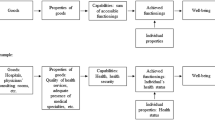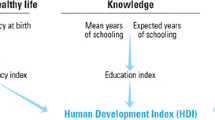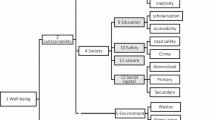Abstract
The territorial approach of rural development requires taking into account economic, social and environmental features. Therefore, among the goals of the rural development policy the well-being of the target population cannot be disregarded. However, well-being is a multidimensional phenomenon and its measure could be complicated since many indicators (with different scale, units of measure, burden, trends) have to be estimated and analyzed. With a composite indicator which summarizes a bulk of information this concern can be overcome. A multicriteria approach of aggregation is proposed because cardinal aggregation involving in undesirable compensatory property.
Similar content being viewed by others
Notes
A (not exhaustive) list includes: the Index of Living Standards proposed by the Fraser Institute; the Weighted Index of Social Progress (WISP) of the University of Pennsylvania; the Index of Economic Well-Being (IEWB) by the Centre for the Study of Living Standards; the Index of Social Health (ISH) of Fordham University; the Oregon Benchmarks by the Oregon Progress Board; the Quality of Life Index (QOL) proposed by the University of Illinois; the Canadian Index of Well-being (CIW) of the Institute of Well-being; the Economic Living Standard Index (ELSI) proposed by the New Zealand Government (Bergheim 2006).
The indicators with no statistically significance difference between agricultural households and non agricultural households are not reported.
The existence of statistically significant differences between the two categories of households will be assessed using the mean t-test, χ2 test or Nonparametric equality-of-medians test.
Reference
Bergheim, S. (2006). Measures of well-being there is more to it than GDP. Research report. Global Growth Centres, Frankfurt am Main.
Casini, L. (1995). Pianificazione territoriale e ambiente. Agribusiness, Management e Ambiente, 2(1), 77–88.
Casini, L., Ciaccia, D., Pizzoli, E., & Boncinelli, F. (2013). Il reddito delle famiglie agricole italiane: stima e analisi. Economia e Diritto Agroalimentare, 18(2), 287–302.
Castle, E. (1998). A conceptual framework for the study of rural places. American Journal of Agricultural Economics, 80(3), 621–631.
Coleman, J. (1999). Foundations of social theory. Cambridge, MA: Harvard University Press.
Dasgupta, P. (1999). Valuation and evaluation: Measuring the quality of life and evaluation policy. Background paper prepared for the World Bank’s annual World Development Report, 2000. World Bank, Washington DC.
Diaz-Balteiro, L., & Romero, C. (2004). In search of a natural systems sustainability index. Ecological Economics, 49(3), 401–405.
Echavarri, R. A., & Permanyer, I. (2008). Ranking profiles of capability sets. Social Choice and Welfare, 31(3), 521–535.
Esty, D. C., Levy, M. A., Srebotnjak, T., & de Sherbinin, A. (2005). Environmental sustainability index: Benchmarking national environmental stewardship. New Haven: Yale Center for Environmental Law & Policy.
Eurostat. (1997). Manual on the economic accounts for agriculture and forestry (Rev.1). Luxembourg: Eurostat.
Eurostat. (2010). GDP and beyond: Focus on measuring economic development and well-being. Sigma—The bulletin of European statistics. Luxembourg: Eurostat.
FAO & World Bank. (2008). Tracking results in agriculture and rural development in less-than-ideal conditions a sourcebook of indicators for monitoring and evaluation. Rome: FAO & World Bank.
Fleurbaey, M., Schokkaert, E., & Decancq, K. (2008). What good is happiness?. Working paper 20. Oxford, UK: Oxford Poverty & Human Development Initiative.
Foster, J. E. (2010). Freedom, opportunity and wellbeing. Working paper N. 35. Oxford, UK: Oxford Poverty & Human Development Initiative
Frank, R. H. (1997). The frame of reference as a public good. Economic Journal, 107(445), 1832–1847.
Frey, B. S., & Stutzer, A. (2002). Happiness and economics: How the economy and institutions affect human well-being. Princeton, NJ: Princeton University Press.
Grosh, M., & Glewwe, P. (2000). Designing household survey questionnaires for developing countries: Lessons from 15 years of the Living Standards Measurement Study. Oxford, UK: Oxford University Press.
Herrero, C., Iturbe-Ormaetxe, I., & Nieto, J. (1998). Ranking opportunity profiles on the basis of the common opportunities. Mathematical Social Sciences, 35(3), 273–289.
Hopkins, J., & Morehart, M. (2004). Assessing farm household well-being beyond farmers and farm income. Amber Waves 2, 8.
Hoskins, B. L., & Mascherini, M. (2009). Measuring active citizenship through the development of a composite indicator. Social Indicators Research, 90(3), 459–488.
ISTAT. (2006). La Rilevazione sulle forze di lavoro: contenuti e metodologie. Metodi e Norme, N. 32, Rome.
ISTAT. (2008). L’indagine europea sui redditi e le condizioni di vita delle famiglie (EU-SILC). Metodi e Norme, N. 37, Rome.
Kahneman, D., Diener, E., & Schwarz, N. (1999). Well-being: The foundations of hedonic psychology. New York: Russell Sage Foundation.
Kahneman, D., Krueger, A. B., Schkade, D., Schwarz, N., & Stone, A. A. (2004). Toward national well-being accounts. American Economic Review, 94(2), 429–434.
Kahneman, D., Krueger, A. B., Schkade, D., Schwarz, N., & Stone, A. A. (2006). Would you be happier if you were richer? A focusing illusion. Science, 312(5782), 1908–1910.
Katchova, A. (2008). A comparison of the economic well-being of the farm and non-farms households. American Journal of Agricultural Economics, 60(3), 733–747.
Kranich, L. (1996). Equitable opportunities: An axiomatic approach. Journal of Economic Theory, 71(1), 131–147.
Layard, R. (2006). Happiness and public policy: A challenge to the profession. The Economic Journal, 116(510), 24–33.
Lee, G. K. L., & Chan, E. H. W. (2008). The analytic hierarchy process (AHP) approach for assessment of urban renewal proposals. Social Indicators Research, 89(1), 155–168.
Lun, G., Holzer, D., Tappeiner, G., & Tappeiner, U. (2006). The stability of rankings derived from composite indicators: Analysis of the “Il Sole 24 Ore” quality of life report. Social Indicators Research, 77(2), 307–331.
Mishra, A. K., El-Osta, H. S., Morehart, M. J., Johnson, J. D., & Hopkins J. W. (2002). Income, wealth, and the economic well-being of farm households. Economic report 812. USDA Economic Research Service, Washington DC.
Munda, G. (2005). Measuring sustainability: A multi-criterion framework. Environment. Development and Sustainability, 7(1), 117–134.
Munda, G., & Nardoa, M. (2009). Noncompensatory/nonlinear composite indicators for ranking countries: A defensible setting. Applied Economics, 41(10), 1513–1523.
Munda, G. (2012). Choosing aggregation rules for composite indicators. Social Indicators Research, 109(3), 337–354.
Ng, Y. (1996). Happiness surveys: Some comparability issues and an exploratory survey based on just perceivable increments. Social Indicators Research, 38(1), 1–27.
Nussbaum, M. C., & Sen, A. K. (1993). The quality of life. Oxford, UK: Clarendon Press.
OECD. (2003). Farm household income. Issues and policy responses. Paris: OECD.
OECD. (2006). Alternative measures of well-being. Social, employment and migration working papers N. 33. Paris: OECD.
OECD. (2008). Handbook on constructing composite indicators methodology and user guide. Paris: OECD.
OECD. (2011). How’s life? Measuring well-being. Paris: OECD.
Oswald, A. J. (1997). Happiness and economic performance. Economic Journal, 107(445), 1815–1831.
Pattanaik, P. K., & Xu, Y. (2000). On ranking opportunity sets in economic environments. Journal of Economic Theory, 93(1), 48–71.
Rosen, R. (1991). Life itself: A comprehensive inquiry into nature, origin, and fabrication of life. New York: Columbia University Press.
Saltelli, A. (2007). Composite indicators between analysis and advocacy. Social Indicators Research, 81(1), 65–77.
Sen, A. K. (1979). The welfare basis of real income comparisons: a survey. Journal of Economic Literature, 17(1), 1–42.
Sen, A. K. (1980). Equality of what. In S. M. McMurrin (Eds.), The tanner lectures on human value (pp. 195–220). Salt Lake City: University of Utah Press.
Sen, A. K. (1982). Choice, welfare, and measurement. Oxford, UK: Basil Blackwell.
Sen, A. K. (1988). The concept of development. In H. Chenery & T. N. Srinivasan (Eds.), Handbooks of Development Economics.. North-Holland: Elsevier Science Publishers.
Start, D. (2001). The rise and fall of the rural non-farm economy: Poverty impacts and policy options. Development Policy Review, 19(4), 491–505.
Stiglitz, J. E., Sen, A. K., & Fitoussi, J. (2009). Report by the commission on the measurement of economic performance and social Progress. http://www.stiglitz-sen-fitoussi.fr/documents/rapport_anglais.pdf.. Accessed 24 Dec 2011.
UN. (2012). Rural households livelihoods and well-Being statistics on rural development and agriculture household income, 2nd Edn. The Wye Group Handbook, FAO, Rome. http://www.fao.org/wairdocs/am087e/am087e.pdf. Accessed 10 July 2012.
UNDP. (2013). Human development report 2013. The rise of the south human progress in a diverse world. Washington DC: UNDP.
Van Praag, B. M., & Frijters, P. (1999). The measurement of welfare and well-being: the Leyden approach. School of economics and finance discussion papers and working papers series. School of Economics and Finance, Queensland University of Technology.
Wolff, E. N., Zacharias, A., & Caner, A. (2005). Household wealth, public consumption and economic well-being in the United States. Cambridge Journal of Economics, 29(6), 1073–1090.
World Bank. (2008). World development report 2008 Agriculture for development. Washington DC: World Bank.
Xu, Y. (2002). Functioning, capability and the standard of living: An axiomatic approach. Economic Theory, 20(2), 387–399.
Zhou, P., Ang, B. W., & Poh, K. L. (2006). Comparing aggregating methods for constructing the composite environmental index: An objective measure. Ecological Economics, 59(3), 305–311.
Zhou, P., & Ang, B. W. (2009). Comparing MCDA aggregation methods in constructing composite indicators using the Shannon-Spearman measure. Social Indicators Research, 94(1), 83–96.
Author information
Authors and Affiliations
Corresponding author
Rights and permissions
About this article
Cite this article
Boncinelli, F., Casini, L. A Comparison of the Well-Being of Agricultural and Non Agricultural Households Using a Multicriterial Approach. Soc Indic Res 119, 183–195 (2014). https://doi.org/10.1007/s11205-013-0488-3
Accepted:
Published:
Issue Date:
DOI: https://doi.org/10.1007/s11205-013-0488-3




